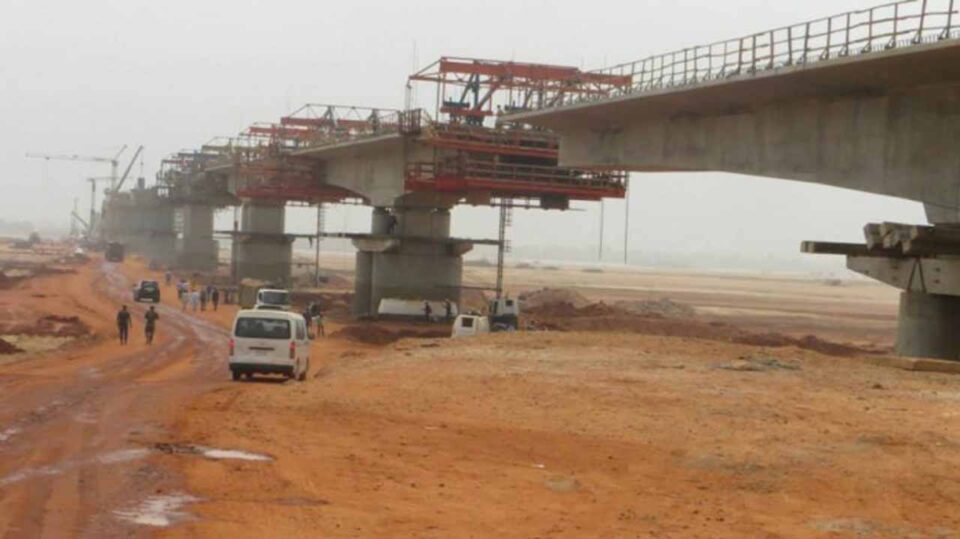Cyriacus Nnaji
Hon (Chief) Modestus Umenzekwe (Onwa Achina) and Chieftain of the All Progressives Congress (APC) has commended the Federal Government, and indeed the Works and Housing Minister, Babatunde Raji Fashola (SAN) and the Labour Minister, Senator Chris Ngige for setting the date for the unveiling of the Second Niger Bridge, which will mark the formal commencement of operation of the world class edifice.
Umenzekwe made the commendation while interacting with journalists in his office in Lagos on Wednesday, March 9, 2022.
Recalled that Chief of Staff to the President, Prof. Ibrahim Gambari, Minister of Works and Housing, Babatunde Fashola and his Labour and Employment counterpart, Chris Ngige, on Tuesday, March 8, 2022, inspected work at the Second Niger Bridge, where Gambari announced that the bridge will be put to public use in October, 2022.
According to report, the trio who were at the Onitsha-Owerri Road Interchange of the link road to the bridge, also walked the entire 1.6km length of the bridge to the Asaba, Delta State end.
The Managing Director of Julius Berger, Mr. Lars Ritchter, who conducted the dignitaries through work at the bridge, said work on the bridge will be completed on April 2.
The delegation also had representatives of Anambra State Government and the Delta State Governments and those of the Nigeria Sovereign Investment Authority (NSIA).
Fashola while having a chat with the media reiterated the completion date saying: “April is the completion date. Earlier, I said it will end in February or latest, end of first quarter.
“Before now, some people said there was no bridge, but now, we are walking on the bridge. This is real now. Plus or minus, when we cross the Ts and dot the Is, we will complete it as promised – 11 kilometres and 12 kilometers on both sides of the bridge.”
Fashola also said that in April, the high tension transmission line across the bridge will be relocated because they were too low on the bridge.
According to Umenzekwe, one man who is over joyed by the speedy completion of the 2nd Niger Bridge project is the Honourable Minister of Labour, Senator Chris Ngige who worked assiduously to ensure that the Second Niger Bridge project was inserted in the APC Manifesto in 2015. Quoting Ngige “The 2nd Bridge which I put in the APC Presidential Campaign manifesto in 2015 is 88% completed and cost is N417B ($700m). It will be completed by mid-April’22 and the connection roads with the interchanges in Delta and Anambra cost is N430b and is 60%. However new temporary connecting roads costing N25b have been designed & will be completed in July.”
Umenzekwe maintained that Ngige has really brought succor through Buhari thereby ending the suffering of the people of the Southeast, South-South, North Central and Southwest.
Analysis have shown that every year, an estimated $5 billion worth of goods pass through the Main Market in Onitsha. Onitsha is also home to Iweka Road, one of the largest distribution networks for Nigeria’s multi-billion-dollar movie industry, Nollywood.
The report also indicates that 30 minutes (or 22 km) away from Onitsha is Nnewi. According to Forbes, it “has bred more billionaires than any other town in Nigeria, and possibly Africa”. Nnewi is also a prominent hub for automobile spare parts dealers, manufacturers of household goods, and many of the largest transport companies in Nigeria. Several of these business activities happen across states and require hours commuting from the East to the West of Nigeria. Indeed it is an economic drain as all these businesses are transacted using just one bridge. Umenzekwe averred that the socio economic importance of the bridge to Nigerians cannot be over emphasized, adding that traffic congestion as a result of the only Niger Bridge is now a thing of the past.
Umenzekwe said that the Federal Government must be seriously commended for the speed, commitment and non-political approach adopted in the execution of the project from the first stage to the last, maintaining that the road was not only completed on record time but, constructed to stand the test of time.
The political stalwart maintained that the Federal Government under the leadership of President Muhammadu Buhari has done what previous governments under the People’s Democratic Party (PDP) could not do having wasted 16 years at the Federal level.
Umenzekwe while reeling out the infrastructural accomplishment of the present government, added that the choice of Fashola as the Minister of Works and Housing has benefitted the southeast more than any other geopolitical groupings in the country.
He said that under the PDP administration, shrubs, weeds and bushes took over the Enugu/Port Harcourt Expressway; the Onitsha/ Enugu Expressway, and the Oba/Onitsha/Okigwe Highway which came alive and rehabilitated under Buhari Regime adding that today, one could drive on those roads with two eyes closed. He said the same thing goes for the Akanu Ibiam International Airport which was Left to rotten by the previous administration.
He called on the people the Eastern geo-political zone to embrace the All Progressives Congress (APC), and said there is nothing igbotic about PDP, “Even when Goodluck Jonathan had his name appended with the baptismal name ‘Ebele’ he did nothing for Ndigbo, therefore the only advisable thing to do is for Ndigbo to embrace a party that has the interest of the people at heart,” Umenzekwe stated.
He described Buhari as a true democrat who has no time for tribal and political considerations in the execution of his infrastructural mantra, saying that if Buhari should look at the infinitesimal percentage of votes he garnered at the pool during the elections of 2015 and 2019 which is infamously known as 5/95%, perhaps he would not have embarked on the gigantic infrastructural development such as the Second Niger Bridge which is more to the benefit of Southeast Nigeria.
He commended other persons, including Senator Chris Ngige who were in the company of the workaholic minister of works to inspect the Bridge “To show their elation and enthusiasm, you see them trekking from Oba end of the bridge to the Asaba end, to see things for themselves. This was not hearsay, they walked on the bridge, not with boat, but using their legs to walk on the bridge, this shows that the bridge has been connected, what is remaining is just a few minor things.”
According to media report, the 1st Bridge is a 1402.08-metre steel truss bridge that connects Onitsha to the rest of Nigeria. It is over 56 years old, dating back to 1965, and is also the primary connection between Eastern and Western Nigeria, two highly industrialized regions, and Nigeria’s population has grown by over 450%, and the amount of people travelling through Asaba and Onitsha has also grown in geometric dimension. This creates a heavy flow of traffic for the travellers and residents of both cities.
It is significant to say that the 2nd Niger Bridge is the creation of a Public-Private Partnership involving the Federal Ministry of Works, the Ministry of Finance, the Nigeria Sovereign Investment Authority (NSIA), the Presidential Infrastructural Development Fund (PIDF), and Julius Berger Nigeria Plc. The project is a Design, Finance, Build, Operate and Transfer (DFBOT) model. This means that the government owns and finances the project’s construction while Julius Berger, a company with a track record of excellence over 50 years, designs and builds.
For Julius Berger, its work on the Second River Niger Bridge consists of constructing two secondary bridges at Amakom Village Road and Atani Road, as well as approach roads from Asaba and Onitsha, a new cloverleaf interchange at Onitsha-Owerri Road, and a toll station.
Work on the bridge comprises the incremental launching of the superstructures for both the western and eastern approach roads, earthworks and road pavements, installation of culverts and stormwater drainage. The current flyover at the Owerri interchange is being demolished and replaced with a new flyover bridge with culverts and a standard drainage system.
The 2nd Niger Bridge already is impacting progress in the region, employing about 1700 people.



